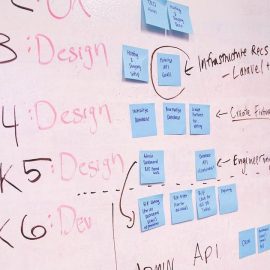
Do you ever worry about not having enough resources to complete an important project? How can you maximize the people and money available to you?
In his book Start Finishing, Charlie Gilkey explains that we typically have more project resources than we realize. Overcoming resource barriers involves finding the right supporters and spending your budget where it matters most.
Read on to discover how to find four types of people who can help your project succeed and learn strategies for making every dollar count.
Your Project Resources
A lack of resources is one of the five common barriers to completing a project. It’s also the only barrier that’s rooted in physical and logistical limitations as well as psychological ones.
However, Gilkey says that you probably have more resources at your disposal than you think. Therefore, overcoming this barrier is a matter of finding the right people to support you and spending your project’s budget—however large or small it is—where that money will have the greatest impact. Let’s get into the details of Gilkey’s recommendations about project resources.
Make the Most of Your People
Gilkey says there are four kinds of people who will naturally want to support you as you work on an authentic project. Finding people from these four categories will enable you to create an effective team to boost your productivity, as well as providing you with the support and motivation you need to see your project through.
Let’s look at the four types of people Gilkey urges you to find.
1. Mentors: People who have already done what you’re trying to do, or something similar. They have experience and knowledge that you lack, so they can provide useful guidance to help you avoid pitfalls and achieve your goals. While professional advisers and coaches will expect to be paid for their services, you can often find people who are happy to share their insights for free.
(Shortform note: Older people are often happy to share their skills and knowledge with those who are less experienced than they are. In From Strength to Strength, management expert Arthur Brooks argues that this is because our creativity and energy decline as we age, but our wisdom and accumulated knowledge continue to grow. Therefore, older people—who might be frustrated by the decline of their own professional skills—tend to embrace opportunities to be useful by teaching or guiding others.)
2. Colleagues: People at roughly your level of experience and skill who are willing to collaborate with you on your project. Aside from helping you with the actual work, such people should also be willing to challenge your ideas and point out your mistakes when necessary. Note that you don’t necessarily have to pay colleagues to get their support; it’s likely they’re working on authentic projects of their own and will be open to exchanging their help for yours.
3. Advocates: People who may not have the skills to directly help with your project, but support you in other important ways. Family members and close friends will often act as advocates—for instance, by offering encouragement and emotional support, helping with day-to-day chores so that you can focus on your work, or lending you money if you need it.
(Shortform note: One of the simplest, yet most effective things colleagues and advocates can do is hold you accountable through specific commitments and regular check-ins. A study by the American Society of Training and Development (ASTD) supports this idea. The ASTD concluded that, if you simply have a goal in mind, you only have about a 10% chance of achieving it. However, if you make a commitment to someone else, your chances of reaching that goal increase to around 65%—and if you schedule regular check-ins with that person to hold yourself accountable, your odds go up to 95%.)
4. Beneficiaries: People who stand to benefit from your project. For example, if you want to create a crew of volunteers to keep the neighborhood clean, then the people who live there are the beneficiaries; if you want to open a business or create a new product, then the people in your target audience are the beneficiaries. Because they benefit from your success, these people may be more likely to help you.
(Shortform note: It may seem odd to insist that an authentic project—something meant to be important and fulfilling to you personally—must have beneficiaries. However, psychology offers one possible explanation: Doing work that benefits others is necessary in order to feel fulfilled. In The Courage to Be Happy, Ichiro Kishimi and Fumitake Koga (citing the work of psychologist Alfred Adler) say that helping others is a fundamental part of feeling welcomed and valued in your community. Those feelings of belonging and worth, in turn, are necessary for your personal health and happiness. In short, although it’s counterintuitive, they argue that the way to make yourself happy is to help make other people happy.)
Make the Most of Your Money
Budgeting is a crucial element of project planning. Gilkey argues that almost all projects require some degree of investment—even if it’s just to buy the supplies you need—so it’s important to set a budget and keep those expenses under control.
The author encourages you to view budgeting as a useful boundary-setting exercise rather than as a restrictive constraint. The goal isn’t just to limit your spending, but for you to strategically use your resources so you can get the best returns on your investments.
For example, instead of hiring a babysitter to watch your children while you work on this project, perhaps you could arrange with some friends to take turns watching each others’ kids for free. You could then use the money you save for something directly related to your project, like upgrading your computer or hiring an assistant.
| Setting a Reasonable Project Budget It can be difficult to come up with an accurate budget, especially if you don’t have any experience as a project manager. One method for creating a budget is the three-point estimation technique, which allows you to cover a wide range of possibilities. This approach involves coming up with three different estimates. The optimistic estimate is how much time and work—and therefore cost—the project will involve if everything goes well. The pessimistic estimate is how much the project will cost if everything that could reasonably go wrong does. Finally, the most likely estimate is exactly what the name suggests: your best guess at how much the project will cost, based on what problems you might encounter and how likely each of those problems is. You can then set your actual project budget by simply taking the average of those three estimates. While the three-point estimation is designed to help you hope for the best and prepare for the worst, many experts recommend setting aside an additional five to 10% of your budget for emergencies. While the estimation will help you prepare for any scenario you can predict, this contingency fund will help you deal with expenses and setbacks you couldn’t predict. |






